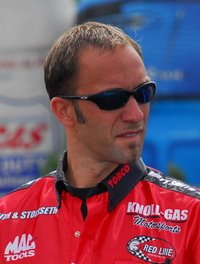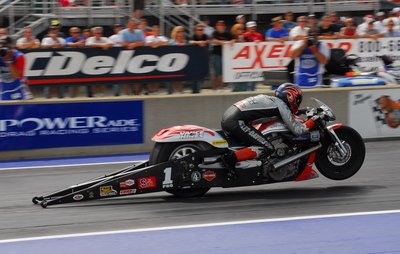THE PSM PARITY GAME
Mon, 2007-07-02 09:46
 A month ago, the NHRA’s technical department added ten pounds to the
minimum weight for Buell Pro Stock Motorcycle teams. In successive
races, the Harley-Davidson and Suzuki teams rewrote the performance
standards. The Buell teams fell behind.
A month ago, the NHRA’s technical department added ten pounds to the
minimum weight for Buell Pro Stock Motorcycle teams. In successive
races, the Harley-Davidson and Suzuki teams rewrote the performance
standards. The Buell teams fell behind.The NHRA made an adjustment earlier this week to restore parity. Instead of removing the extra ten pounds from the Buells, the NHRA gave back five pounds and nailed the Harley-Davidsons and Suzukis for a five pound increase.
Wouldn’t it have been easier to remove the 10-pound adjustment to the Buell teams to achieve the unified minimum weight? That’s the question pondered by many in the class.
“I think they know they made a mistake,” said Matt Smith, the rider cited for the Buell weight adjustment following his record-setting performance in St. Louis. “They’ll probably never admit it. It hurt us for a couple of races and luckily we have this new Countdown to the Championship. Each race is not as critical as it used to be.”
 A month ago, the NHRA’s technical department added ten pounds to the
minimum weight for Buell Pro Stock Motorcycle teams. In successive
races, the Harley-Davidson and Suzuki teams rewrote the performance
standards. The Buell teams fell behind.
A month ago, the NHRA’s technical department added ten pounds to the
minimum weight for Buell Pro Stock Motorcycle teams. In successive
races, the Harley-Davidson and Suzuki teams rewrote the performance
standards. The Buell teams fell behind.The NHRA made an adjustment earlier this week to restore parity. Instead of removing the extra ten pounds from the Buells, the NHRA gave back five pounds and nailed the Harley-Davidsons and Suzukis for a five pound increase.
Wouldn’t it have been easier to remove the 10-pound adjustment to the Buell teams to achieve the unified minimum weight? That’s the question pondered by many in the class.
“I think they know they made a mistake,” said Matt Smith, the rider cited for the Buell weight adjustment following his record-setting performance in St. Louis. “They’ll probably never admit it. It hurt us for a couple of races and luckily we have this new Countdown to the Championship. Each race is not as critical as it used to be.”
Many of the riders Torco’s CompetitionPlus.com questioned pointed out the elapsed time advantages came in the early part of the track, an area normally not equated to horsepower gains. First-half gains are usually attributed to clutch superiority. At least that’s how Chip Ellis sees it.
“Matt was making his gains in the first 300 feet of the race track and that equates to clutch gains, not horsepower,” Ellis said. “He didn’t really run any quicker in the back-half [eighth-mile to quarter-mile] than any of the other Buells. He didn’t have any more horsepower than any one else, he just had his tune-up figured out.”
That is why Smith feels the latest rule amendment still isn’t enough. Based on the back-half figures from Chicago and Englishtown, Smith wouldn’t have a problem with the Harley-Davidson and Suzuki brand carrying an extra five pounds.
“It’s the NHRA’s call, but at least we’re a little closer than we used to be,” Smith said.
Smith confirms his early gains are a direct result of automobile drag racing technology. The son of legendary doorslammer Rickie Smith has borrowed clutch technology from his dad and a bit of engine know-how from noted mountain motor specialist Sonny Leonard.
“I think having the car stuff incorporated is going to make us a force to be reckoned with,” Smith said. “We have a lot of new parts being built. We haven’t shown anything so far compared to what we have for the future. Sonny Leonard has some parts for us that are going to make a difference. We also have a chassis dyno, thanks to Evan Knoll.”
Having the auto technology available could make the Buell combination a future target for more rule amendments. Smith isn’t scared of new “Matt Smith” rules.
“I just want to win and that’s what it is all about,” Smith said. “If the NHRA will look at the back-half numbers, then they will see the true horsepower values. You can forget about the sixty-footers, that’s all about tuners and riders.”
Smith says the practice of Pro Stock Motorcycle borrowing from their four-wheel counterparts is nothing new. In his days aboard a Suzuki, he implemented technology provided by Reher-Morrison.
Andrew Hines declined to comment on the recent weight minimum adjustments. He and his team, as well as the Team Army camp, were the target of many accusations of lobbying for the initial Buell weight adjustment. Those allegations led Hines to respond directly on the Nitromater.com message board.
“It never sets well with you when people talk about you behind your back,” Hines said. “We are just out here trying to race and not trying to get the rules changed. We want to have fun and most of all we want everyone to like us. We don’t want to make enemies out here. We just want to have fun and race.”
Hines should know the sting felt by the Buell riders, because he admits the Harley-Davidson teams have made their fair share of adjustments at the hands of rule-makers.
 “We had our fair share of those changes back in the early days,” Hines
said. “It’s just part of the game and they have to find parity somehow.
There are different ways of doing it. You just never know how.”
“We had our fair share of those changes back in the early days,” Hines
said. “It’s just part of the game and they have to find parity somehow.
There are different ways of doing it. You just never know how.”The NHRA’s Don Taylor admitted the recent wave of weight adjustments were intended to create a universal learning curve. When asked if they were a part of limiting performance, he downplayed the validity of a rumor suggesting a memo had been issued declaring a performance-limiting edict.
“I think right now that our class is the most difficult to create parity,” said Steve Johnson, Suzuki rider and president of PRO2, the voice of the Pro Stock Motorcycle division. “I think it is going to be difficult to maintain it race after race after race. I told all of the members when the NHRA put the ten pounds on the Buells to just step back and take a breath because I know it’s frustrating.
“This is the furthest thing from being politically correct that I can say but the NHRA is still trying to put their hands around how to manage our class to a top level. We are a sophisticated class. We are our own class. They are trying to create parity amongst four different engine brands with weight breaks. The NHRA’s hands are full and this scenario is just the tip of the iceberg.”
The NHRA’s titanic decision become unavoidable after Sampey’s record-setting 6.871 during Englishtown qualifying.
“When they saw Angelle run that 6.87, they knew they had to do something,” Ellis said. “I don’t know if adding ten pounds to us was the right thing to do. I think maybe they should have played it out to see what happened. It is what it is and we’ll just do the best we can with it. We are all back equal again.”
Categories:




































